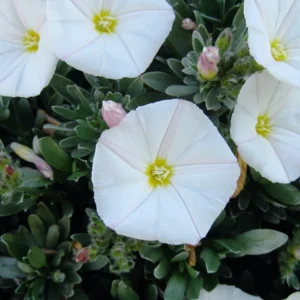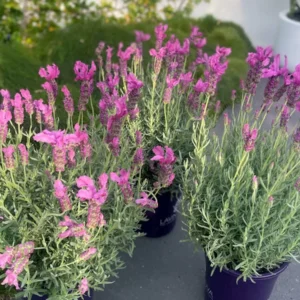French Lavender: Nature's Purple Delight
The Lavandula French lavender is a wise addition for any garden in Australia — its grey-green foliage and soft purple flowers are downright attractive but in a classy kind of way. It helps that it can also be used for aromatherapy and cooking, making it exactly the kind of plant that most gardeners are looking for.
Even better, it is easy to care for and very versatile, so you can expect it to fit any garden style, whether you’re looking to follow a cottage garden design or a Mediterranean-inspired style, French lavender’s simple beauty will fit right in.
How to Plant French Lavender?
Another benefit of Lavender dentata is its ability to flourish in Australia’s diverse climates, so you can expect to succeed in growing these flowering plants as long as you give them enough care. Here are essential things to know about planting French lavender.
- As with all lavender species, it is recommended to plant French lavender in spring so it has time to establish itself prior to the summer heat.
- Use dry, well-draining, slightly alkaline soil for ideal results.
- Lavender dentata is best grown in a sunny location.
- Once established, Lavender dentata is drought tolerant; overwatering is not recommended, water deeply but not too often.
Why Should You Buy French Lavender?
The calming scent of the Lavandula French lavender is another reason why this flowering plant native to the Mediterranean is a must-have addition to your garden.
Here are other reasons why planting French lavender in any garden is worthwhile:
- Planting French Lavender is Easy: Simply plant it in well-draining soil in a sunny spot. It’s drought-tolerant and thrives in poor soil with low nutrients to moderately fertile soils, making it an easy-care option for your garden.
- French Lavender Smells Heavenly: The aromatic foliage and flowers of French lavender exude a delightful scent, creating a relaxing and pleasant atmosphere in your garden or patio.
- They’re Hardy, Low-Maintenance Plants: French lavender is drought-resistant and thrives in Australia’s sunny climates. It requires minimal care, making it perfect for both experienced and novice gardeners.
- French Lavender Has Multiple Other Uses: Used in aromatherapy, the calming scent can be used to relieve stress and reduce anxiety.
How to Care and Grow French Lavender?
This hardy, flowering plant can withstand Australia’s diverse climates, making it easier to care for.
Here are some basics you need to know when caring for Lavandula French lavender:
- Initially, water the plant thoroughly after planting to help settle the soil around the roots. Once established, French Lavender is drought-tolerant and requires minimal watering.
- Water only when the top inch of soil is dry, and avoid overwatering, especially in humid climates.
- French lavender has evolved to grow well in poor, dry soil, so there’s no need to fertilise. On rare occasions when deemed necessary, only use a light application of balanced, slow-release fertiliser in spring.
- Freezing temperatures and high humidity compromise your French lavender’s potential to thrive. Ensure you’re planting and growing it in dry, warm areas.
- It is best to prune French lavender in early spring, especially if you live in a temperate climate with cold winters, to foster new growth and increase generation of flowers.
Things to Consider When Growing French Lavender
When it comes to growing French lavender or Lavandula dentata, there are some considerations that need reviewing to make sure that your plant flourishes. The first one is climate; while Lavender dentata thrives in Australia’s diverse climates, it can mostly handle hot summers.
In high temperatures, it’s going to need afternoon shade to protect it from potential stress. During winters, lavenders can deal with cool weather, but not drafty.
High humidity is another issue because French lavenders prefer low to moderate only. If you live in a region with high humidity, you can protect the plant by ensuring efficient drainage and good air circulation to prevent fungal diseases.
Overall, lavender flowers bloom year round (preferably in warm climates) depending on where you live, which, of course, impacts your plant’s growing conditions.
Treating Your French Lavender For Signs of Disease and Pests
Treating plant pests and diseases requires early detection to stop it from spreading and harming your plant. In the case of the Lavandula dentata, the only disease to watch out for is rot (root rot and crown rot).
With root rot, it is typically caused by poor drainage or overwatering, which then causes French lavender’s leaves to turn yellow and delay in growth as the roots are plagued by fungal infections.
Remedies include improving drainage, reducing watering, and using fungicides. If you live in an area with higher rainfall, planting on a berm with a gravel mulch could help with drainage.
Moreover, the plant is not often affected by pests. In fact, it is a natural repellent for insects thanks to its fragrant aroma. It is also not appealing for chewing pests because of the high concentration of essential oils in both flowers and foliage.
Still, a few insects still give it a go, including spittlebugs, whiteflies, and aphids, so watch out for those and use treatment when necessary.
Where Can I Buy Lavandula Dentata?
Adding Lavandula dentata to your garden is worthwhile seeing that it offers benefits that are beyond its aesthetic value.
Whether you’re looking to create a lavender hedge, a potted spectacle, or a Mediterranean-themed garden, this purple delight of a flower with aromatic leaves is the perfect choice.
Are you looking for a collection of French lavender for sale? We offer the best lavender plants and carry out plant delivery to the Gold Coast area, Northern NSW, Brisbane and Sunshine Coast. Check out our Plantastic Delivery section for more shipping information.
Lavender Companion Plants You Might Like
To complement your new plant, consider adding other Mediterranean or drought-tolerant species. Here are some suggestions:
- Rosemary: Being an aromatic herb, Rosemary pairs beautifully with Lavandula dentata, creating a fragrant and visually appealing garden bed.
- Salvia: Featuring bold spikes of purple or blue flowers, Salvia adds an outlandish contrast to the milder hues of lavender.
- Olive Tree: For a Mediterranean-inspired garden, plant an olive tree alongside Lavandula dentata for southern European vibes.
- Euphorbia: The unique texture and colour of Euphorbia provide an interesting contrast to the soft, bushy appearance of lavender.
| Weight | 0.5-1 kg |
|---|---|
| Pot Size | 250mm pot |
Detailed Information
| Typical height | 30-60 cm |
|---|---|
| Minimum temperatur tolerance | Can withstand temperatures as low as -5°C but prefers milder climates |
| Climate | Mediterranean, temperate, and subtropical regions |
| Light conditions | Full sun |
| Growth habit | Bushy, upright with slightly toothed leaves |
| Growth conditions | Prefers well-drained soil, low to moderate water, and full sun exposure |
Q: When is the best season to buy French Lavender in Australia?
Spring! This allows the plant to establish itself before the hot summer months.
Q: How much water does French Lavender need?
French Lavender is drought-tolerant, so watering frequently actually leads to more problems. It is recommended to water sparingly once established, particularly in areas with high rainfall.
Q: Can French Lavender grow in pots?
As a versatile flowering plant, yes, French Lavender grows well in pots. Just make sure the pot has good drainage and place it in a sunny location. Use a well-draining potting mix to prevent root rot.
Q: How do I care for French Lavender in winter?
Unlike English lavender, which is cold hardy, French lavender prefers warm and dry areas, although it’s still possible to grow it in winter. In regions with frost, provide some protection or move potted plants to a sheltered location. Pruning after flowering helps maintain a compact shape and encourages new growth.
Q: How tall does French lavender grow?
French Lavender (Lavandula dentata) generally grows up to 90 cm.
Q: Where can I buy French Lavender in Australia?
You can buy French Lavender online right here at Local Botanist. Whether you’re in the Gold Coast or Northern NSW, we’ve got you covered.
French Lavender
Lavandula Dentata Frenchette
- In stock
- Delivery within 1-3 days based on location.
- Local pickup by appointment only
- Delivery Fees and Minimum Purchase
The aromatic foliage and captivating blooms of Lavender Dentata (French Lavender) makes it a welcome sight in any garden. The grey green leaves are a refreshing spectacle and the French lavender flowers (lilac in spring, purple in summer) are just as invigorating. Not only is it a classic garden favourite that serves as an ornamental plant, it’s also enjoyed in aromatherapy and used as a culinary herb. Add French lavender to your garden today!
Synonyms: Lavandula dentata, Fringed lavender
Payment methods
Your payment information is processed securely. We do not store credit card details nor have access to your credit card information.








Reviews
There are no reviews yet.